
Anybody who has read my work over the years, know that I have promoted a number of former NFL players for the Pro Football Hall of Fame. Most notably among that group of players was Jerry Kramer, and he indeed was enshrined in Canton in 2018. I first started writing about Kramer’s omission from his rightful place in the Hall of Fame over 30 years ago.
And it was through my association with Kramer over the years which led me to new friendships with people like his former teammate with the Green Bay Packers, Don Horn. One of the reasons I got to know Horn was because of his background in stem cell therapy and it was Kramer who first got Horn interested in that subject matter.
It was through Horn that I got to know Kandace Saberhagen, who was the president of Premier Stem Cell Institute, where Horn was a liaison to former NFL players who could utilize stem cell therapy to help them recover from shoulder, knee and hip injuries that they had suffered in the past.
I wrote a four-part series about stem cell therapy back in August of 2016 and have remained friends with Kandace ever since. Which takes me back full circle, as like with Kramer and other NFL players who I promoted for the Pro Football Hall of Fame (like Class of 2020 member Bobby Dillon), I also believe Kandace’s husband Bret Saberhagen deserves consideration for the National Baseball Hall of Fame.
There are just 21 multiple winners of the Cy Young Award in MLB history, and Saberhagen is one of them, as Bret won his first in 1985 and his second in 1989 as a member of the Kansas City Royals.
Saberhagen was also named World Series MVP in 1985, as his Royals defeated the St. Louis Cardinals in seven games. Saberhagen was 2-0 (including a shutout) in that World Series and had a sparkling 0.50 ERA, plus gave up just 11 hits in 18 innings. No. 31 also had 10 strikeouts and gave up only one walk.
If one looks at Saberhagen’s career stats, his numbers are quite good. He was 167-117 with a career ERA of 3.34, which adds up to a .588 winning percentage, which is better than a lot of pitchers in the Hall of Fame. There are 80 pitchers in the Hall of Fame and Saberhagen has a better winning percentage than 38 of those pitchers.
The career ERA of 3.34 is also good, as he pitched in the American League for 11 of the 16 seasons he played in baseball. The American League has the DH, unlike the National League.
A number of the years when Saberhagen pitched were marred by injuries, which will be addressed later in the story. In fact, Saberhagen was actually in MLB for 18 years, but two full years were lost because of injury.
Saberhagen was also a three-time All-Star, plus won a Gold Glove and also won the ERA title in 1989 when he won his second Cy Young Award.
From 1985 through 1989, there wasn’t a better pitcher in the American League, as Saberhagen won two Cy Young Awards, won 82 games and lost 50 and had an overall ERA of 3.27.
When one looks at the 167 wins that Saberhagen had in his career, there are three other starting pitchers in the Hall of Fame that have similar win totals. I’m talking about Sandy Koufax, Dizzy Dean and Lefty Gomez.

Koufax was 165-87 in his career with the Brooklyn/Los Angeles Dodgers with a career ERA 0f 2.76. No. 32 also won three Cy Young Awards, won a National League MVP , was a World Series MVP twice, a seven-time All-Star, a three-time triple crown (wins, ERA and strikeouts) winner and was a five-time ERA leader.
Dean was 150-83 in his career with the St. Louis Cardinals and Chicago Cubs and had a career ERA 0f 3.04. Dean was a National League MVP in 1934 when he won 30 games. There was no Cy Young Award then. Dean was also a four-time All-Star.
Gomez was 189-102 with the New York Yankees and Washington Senators with a career era of 3.34. Gomez was a seven-time All-Star, won two triple crowns and was a two-time ERA leader.
When I was promoting Kramer for the Pro Football Hall of Fame, one of the things I put out there were the many endorsements from Hall of Fame players that Kramer received in his career before he was inducted. None were bigger than the three he received from Merlin Olsen, Alex Karras and Bart Starr.
Likewise, I wanted to talk with three Hall of Fame baseball players about Saberhagen. The three I talked to were Larry Walker, Robin Yount and Rollie Fingers. I never had talked with Walker before, but I did interview Yount and Fingers a few times when I covered the Milwaukee Brewers from 1980 through 1983.
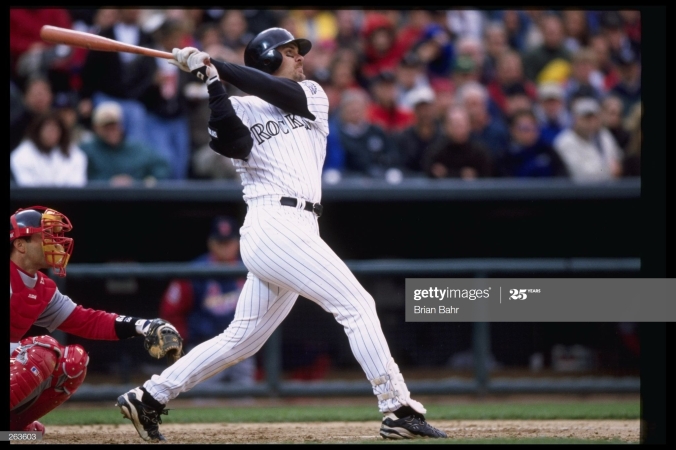
Walker briefly played against Saberhagen when he was a member of the Montreal Expos and Saberhagen was pitching for the New York Mets. Walker talked about what it was like facing Saberhagen.
“When you look at Bret on the mound, he sort of reminded me of Pedro Martinez,” Walker said. “Not very intimidating. He’s not a mean looking guy. Not big or strong looking. But with both of those guys, once the ball leaves their hands, they definitely become intimidating.
“The life on Bret’s fastball is something I’ll always remember. Similar to Dwight Gooden and David Cone, as his fastball could buckle your knees at times and make you shake your head. I remember the first time I faced him and it was almost like his ball was rising as it came to the plate. Plus he had a sharp curveball and they were just nasty pitches. You were hoping that he wasn’t on that day, so maybe you could scrape out a hit.”
Very humble words from Walker, who once hit over .360 for three consecutive years when he was with the Colorado Rockies, plus won three batting titles and was a five-time All-Star. A superb fielder as well, as he also won seven Gold Glove honors. That all led to Walker being named to the Class of 2020 for the National Baseball Hall of Fame, along with Derek Jeter, Marvin Miller and Ted Simmons.
Walker also loved being teammates with Saberhagen when both played for the Rockies.
“Bret was as solid as one could be. A guy you love in the clubhouse,” Walker said. “He was always talking and communicating. And that’s a good thing, because it’s rare too, but pitchers normally don’t jell that well with position players, but Bret did.”
Although Walker just recently was named to be a member of the Hall of Fame, he talked about why Saberhagen also should be considered.
“You know, Bret won two Cy Young’s and a was a World Series MVP. He has that definitely going for him,” Walker said. “It’s a fine line. I think he only had a few people vote for him the last time he was on the ballot, which is ridiculous. There are a bunch of players who I think belong, but you kind of shake your head in disbelief that they don’t get more respect from the voters. I know his win total isn’t as high as some of the voters would like, but injuries put a little damper on his career.
“I’m glad that you are promoting Bret. Hopefully you can help open some eyes. You never know. If it (the Hall of Fame) could happen for me, it can happen for anyone.”
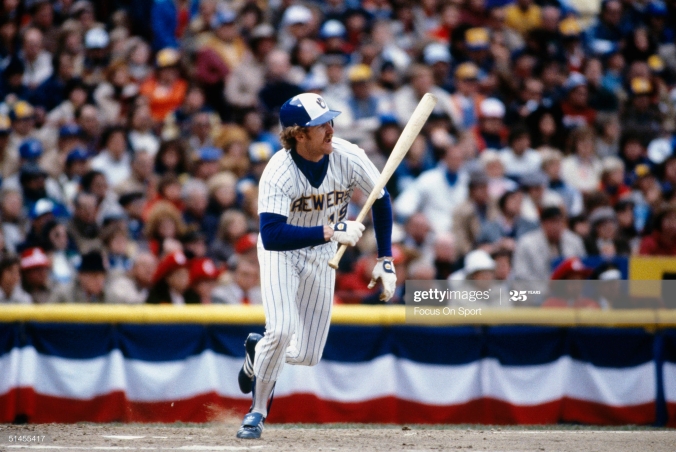
When Yount played, he and Saberhagen were considered two of the best players in the American League and in all of baseball. Yount was the AL MVP in both 1982 and 1989. Saberhagen won the Cy Young Award in 1985 and 1989. Saberhagen was also World Series MVP in 1985 and Yount probably would have been in 1982, had the Brewers defeated the Cardinals in that World Series. Yount hit .414 in that World Series and if Fingers (out with an elbow injury) had been available to pitch, the odds were pretty good that the Brewers would have won that Fall Classic.
Yount faced Saberhagen many times in his career.
“I certainly remember his high, hard fastball and his sharp curve,” Yount said. “Those two pitches were outstanding and they turned out to be good enough to win him two Cy Young’s and a World Series MVP. To me back at that time, Bret was one of the top pitchers in all of baseball.
“I also remember that we played high school baseball in the same area of Los Angeles, the San Fernando Valley area. We sort of grew up in the same type of baseball atmosphere.
“Doing what you are doing in promoting Bret is what it takes. I’ve been part of the Modern Baseball Committee for the Hall of Fame a couple of times and we get to discuss and vote on ten nominees who have been presented to our committee. That is how Ted [Simmons] got in.
“Being a two-time Cy Young winner and being a World Series MVP like Bret was, it’s hard to believe he was taken off the Hall of Fame ballot after one year due to lack of votes. Hopefully he can be a nominee on one of the Hall of Fame’s committees so his accomplishments in baseball can be discussed by the members of that particular committee.”
The Hall of Fame has four Era Committees which vote on 10 candidates in each committee for selection into getting a plaque in Cooperstown. The four Era Committees are Early Baseball (Prior To 1950), Golden Days (1950-1969), Modern Baseball (1970-1987) and Today’s Game (1988 To Present).
Saberhagen is characterized as to belonging in the Today’s Game category, as the bulk of his career was played from 1988 to present. The Today’s Game Committee has 16 members, which will be a mixture of Hall of Fame players, MLB executives and writers. The list of 10 candidates for each committee is put together by the Historical Overview Committee.
The Historical Overview Committee is comprised of 11 veteran historians: Bob Elliott (Canadian Baseball Network), Jim Henneman (formerly Baltimore Sun), Steve Hirdt (Elias Sports Bureau), Rick Hummel (St. Louis Post-Dispatch), Bill Madden (formerly New York Daily News), Jack O’Connell (BBWAA), Jim Reeves (formerly Fort Worth Star-Telegram), Tracy Ringolsby (MLB.com), Glenn Schwarz (formerly San Francisco Chronicle), Dave Van Dyck (formerly Chicago Tribune) and Mark Whicker (Southern California News Group).
The Today’s Game Committee will meet again in December of 2021 to discuss who might get inclusion in the Class of 2022.
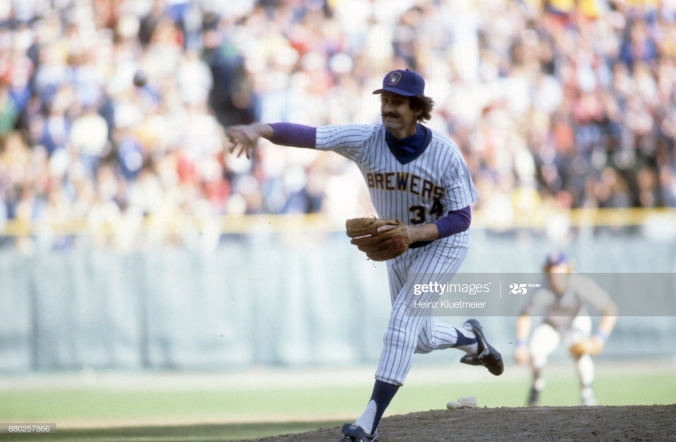
I also had the opportunity to talk with Fingers about Saberhagen. They both have a couple things in common. Both have been World Series MVP’s and both have won at least one Cy Young Award.
Although Fingers started out his career as a starter like Saberhagen, he eventually became one of the best closers in the history of the game, as he ended up with 341 saves. Fingers retired after the 1985 season, which also happened to be the year that Saberhagen won his first Cy Young and was the World Series MVP as well.
“I remember Bret, as I was with with the Brewers in ’84 and ’85 when he first got started in baseball,” Fingers said. “I remember that he threw really hard. I’m glad I never had to face him because we had the DH, but I know that in his first five or six years he was with the Royals, he was the cat’s meow in the American League, winning a couple of Cy Young Awards and also being the MVP of the ’85 series.
“Bret had some great years. Now he only won 167 games, but he had a pretty good winning percentage at .588. Plus he had 76 complete games, which is not bad. In fact, it’s pretty good. Nowadays in baseball, if you had 76 complete games in total for pitchers over two years, that’s considered good.
“Looking at Bret, obviously winning two Cy Young’s and being a World Series MVP is very good. He was also a three-time All-Star. Two more All-Star appearances might have helped his cause.”
Ironically, in 1985 and 1989, the two years he won the Cy Young Award, Saberhagen was not named an All-Star, which is unbelievable.
Fingers continued talking about the stats of Saberhagen.
“A lifetime ERA of 3.34 is pretty good. So is over 2,500 innings pitched. Having only 167 wins will go against him a bit. But Sandy Koufax is in the Hall of Fame with less wins (165) than that, but he also won three Cy Young’s and struck out the world when he played. But all in all, Bret had a great career in baseball.”
Fingers was on the top of his game in 1982 when he suffered an elbow injury in early September which cost him the rest of the season and all of the 1983 season. At the time of his injury, Fingers was the defending Cy Young Award winner, as well as the defending AL MVP.
Likewise, injuries have hurt Saberhagen throughout his career in baseball, which definitely curtailed some of the stats he might have put up in the big leagues. Saberhagen and I talked about that and much more when we recently talked about his baseball career.
It was at a fairly young age when Saberhagen thought he had a chance to maybe get to the big show.
“I think I was pitching in high school when scouts were coming around,” Saberhagen said. “I never imagined that I would have the career I ended up having though. I was pretty much throwing just fastballs and curveballs back then.”
But it was when Saberhagen developed a great changeup which really set his career in baseball upward.
“In high school, I was trying to come up with an offspeed pitch. I was trying the knuckleball, but nothing really clicked. But in the minors when I was in AA ball, Tony Ferreira showed me how to hold the baseball to basically throw a screwball. I held my fingers down on each one of the seams and pulled down with my index finger and I was able to control that with a different velocity. That’s what really made a huge difference with my repertoire. Without that pitch, I probably wouldn’t have had the career I did.”
Saberhagen got off to a quick start in the majors, as he made the Royals out of AA ball in 1984 and won 10 games as a rookie with a 3.48 ERA. Things really took off in 1985, when he won the Cy Young Award with a 20-6 record and an ERA of 2.87. Plus he led his team to the World Series title, as he was the MVP of that series.
Saberhagen didn’t do it alone though and he wanted to make sure that the guys who were catching him got a lot of credit.
“The guys who caught me were very knowledgeable and had been around. In 1985, Jim Sundberg caught me and we are talking about a guy who caught a number of no-hitters from Nolan Ryan. With a guy like Jim, he knows what pitches to throw depending on the situation in the game. I very seldom shook him off.
“I had four guys who I really enjoyed throwing to. There was Jim, Bob Boone, Charlie O’Brien and Jason Varitek. With all four of those guys, if I shook off those guys five times in a game, that would probably be the max. And if you are not shaking off, you get into a nice rhythm and groove.”
Saberhagen was definitely in a groove in 1985 when he won his first Cy Young Award and then really made a name for himself in the 1985 World Series.
“It was funny in the 1985 postseason, as I had struggled against the Toronto Blue Jays in the ALCS, who I always seemed to struggle against,” Saberhagen said. “My mindset in the World Series was to get my shit together.”
And indeed, Saberhagen sure as hell did. With the Royal down two games to zero in the series, Saberhagen was faced with a must-win start in Game 3 at Busch Stadium. And No. 31 delivered big time, as the Royals beat the Cardinals 6-1, as he pitched a complete game and allowed just six hits, while he struck out eight and walked just one.
The Royals extended the series to Game 7, when Saberhagen got his second start of the series. This time the game was played at home at Royals Stadium. Saberhagen was again magnificent, as he pitched another complete game, but this time it was a shutout, as the Royals won 11-0 and had their first World Series title. Saberhagen allowed just five hits, as he struck out two and walked nobody.
Because of his performance in the series, Saberhagen was named the MVP.
When I was a kid, I always dreamed about playing in a Game 7 in the World Series and being the hero. I know that is the same dream with many kids who grow up loving baseball. Saberhagen accomplished that goal and it had to be just a fantastic feeling.
“Winning Game 7 of the World Series was my biggest thrill for sure.” Saberhagen said. “Second would be pitching a no-hitter and third would be starting an All-Star game.”
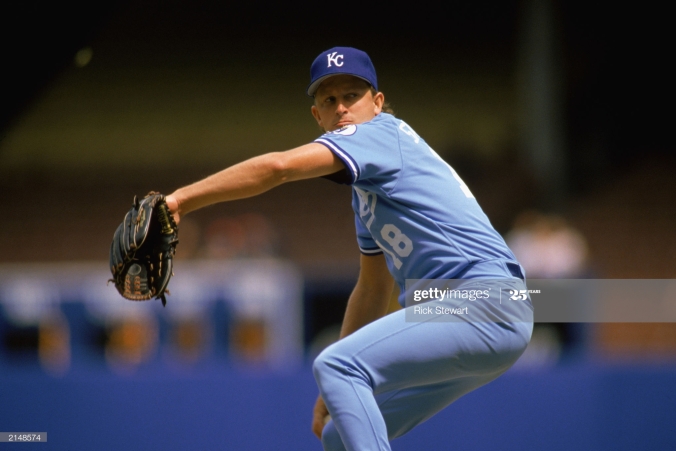
Saberhagen remained one of the very top pitchers in the American League for the next four years, which culminated when he won his second Cy Young Award in 1989. That season Saberhagen was just nasty on the mound, as he was 23-6 with an ERA of just 2.16. He also had 12 complete games and four shutouts. In addition, Saberhagen allowed just 209 hits in 262.1 innings.
No wonder he won another Cy Young!
Some shoulder woes affected Saberhagen in 1990, as he was just 5-9 with an ERA of 3.27, but he was named to the All-Star team and got the win in that game. In 1991, Saberhagen bounced back and was 13-8 with an ERA of 3.07.
In 1992, Saberhagen was traded to the New York Mets. In three and a half seasons with the Mets, Saberhagen was 29-21 with an ERA of 3.16. His best year was in 1994, when he went 14-4 with an ERA of 2.74 and finished third in the NL Cy Young voting. The most amazing aspect of that season for Saberhagen was his 11-1 strikeout to walk ratio.
At the trade deadline in 1995, Saberhagen was traded to the Colorado Rockies and went 2-1 in three starts.
“Unfortunately, I only pitched three healthy games with the Rockies,” Saberhagen said. “After my third start, the next day we traveled to Pittsburgh and we did our stretching and I went out to warm up and the first throw I made felt like a bomb blew up in my shoulder. The team did a MRI which said the shoulder was fine and just needed some clean up after the season was over.
“Needless to say, it would take me over a half hour to get loose before a ball game and my curveball was not there anymore either. It was tough to throw the changeup and my fastball was all over the place. I ended up getting two more shots of cortisone and I was living on anti-inflammatories throughout that season. I finally had surgery that offseason and the surgery was performed by Dr. Altchek by the Mets. I was put under, but I wasn’t completely out because he wanted to talk with me during the procedure.
“So when he went in, he asked me what happened and I explained. And then he told me that everything in my shoulder was gone. He said that my supraspinatus, infraspinatus and other muscles were all torn. He told me that he wasn’t going to do reconstructive surgery at that point, but that it would probably have to be done later. He just fixed it as best as possible so I could pitch the next year. But by May next year in 1996, my shoulder was still killing me and I did have reconstructive surgery and I missed all of the ’96 season.
“One of the things that I think about is the fact that I was injured quite a bit and if there was one thing in my career that I would like to change, it would be being healthy a lot more. I had a big league uniform on for 18 seasons and I missed two of those seasons completely due to injury, plus had a number of other seasons cut short due to injury.”
In 1997, Saberhagen signed with the Boston Red Sox as a free agent. In five years with the Red Sox, Saberhagen’s point about being injured often is illustrated quite clearly. In 1996, Saberhagen only pitched in six games and in 2001, only pitched in three games due to shoulder woes. Plus, he missed all of the 2000 season.
But in the two years that Saberhagen was able to pitch, he looked a lot like the old Saberhagen, as he was 25-14 in 1998 and 1999 combined with a cumulative ERA of 3.46 for the Sox. He also struck out 181 hitters and walked just 41 (one intentional).
Looking back on his injury woes, Saberhagen reflected.
“Sometimes when you have a MRI, it misses things that are issues,”Saberhagen said. “But back then, that’s what we were working with. And you did what you had to do to get back on the mound. You got your shots of cortisone and lived on anti-inflammatories. That was just the way we were programed. You just had to what you could to get back out there.”
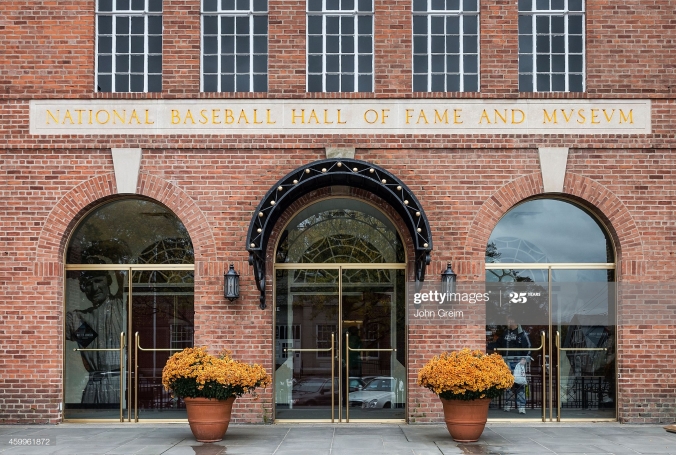
The bottom line is that when healthy, Saberhagen was one of the top pitchers in all of baseball and his two Cy Young Awards and his World Series MVP bear that out. Saberhagen certainly deserves to be nominated to be one of the 10 players discussed by the Today’s Game Committee in the fall of 2021 to debate if he warrants a plaque in Cooperstown.
The 16 people on that committee can make that determination, but at the very least, Saberhagen deserves the opportunity have his name put back into the discussion about being in the National Baseball Hall of Fame.
Bob Fox, being a KC Royals fan since the beginning (1969) I’ve witnessed many games over that timeframe. Bret was as great or better pitcher through his Royals career (and after) as I’ve had the privilege to watch & follow. You made several excellent points as to why he deserves to be on the 2021 ballot. My question to you Bob, is there a way we as fans can contact the “Today’s Game Committee” to request they add Bret to the ballot? Thanks in advance…
LikeLike
Hi Rick,
The folks who will put the nominees on the Today’s Game Committee in 2021 will be determined by the Historical Overview Committee. Those members are: Bob Elliott (Canadian Baseball Network), Jim Henneman (formerly Baltimore Sun), Steve Hirdt (Elias Sports Bureau), Rick Hummel (St. Louis Post-Dispatch), Bill Madden (formerly New York Daily News), Jack O’Connell (BBWAA), Jim Reeves (formerly Fort Worth Star-Telegram), Tracy Ringolsby (MLB.com), Glenn Schwarz (formerly San Francisco Chronicle), Dave Van Dyck (formerly Chicago Tribune) and Mark Whicker (Southern California News Group). I would suggest either contacting these writers personally regarding your support for Bret, or by sending a letter of support for Bret to:
National Baseball Hall of Fame and Museum
c/o The Historical Overview Committee
25 Main Street,
Cooperstown, NY 13326
All the best,
Bob
LikeLike
I loved following Bret’s career! He was a good man on and off the field. He gutted out some tough injuries for pitchers and still has Hall of Fame numbers. He deserves to be in the HoF as much as any great pitcher I’ve seen! Thanks for the piece!
LikeLike
Pingback: Bret and Kandace Saberhagen: A Perfect Blend | Bob Fox
Pingback: Why Lew Burdette Deserves Consideration for the National Baseball Hall of Fame | Bob Fox
Pingback: Robin Yount: The Greatest Milwaukee Brewer of Them All | Bob Fox